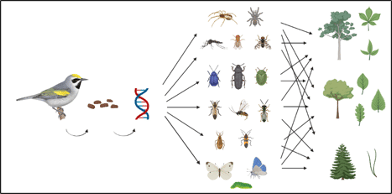The U.S. Department of Defense (DoD) owns military installations on nearly 27 million acres all over the country—roughly equivalent in size to Virginia—and oversees these lands through a network of natural resource managers. According to the DoD, the program supports “the military’s testing and training mission by protecting its biological resources… and working to ensure the long-term sustainability of our nation’s priceless natural heritage.” One of the program’s top priorities is monitoring and maintaining populations of threatened and endangered species (TES) of birds—especially those that eat insects and other arthropods like spiders, which have been particularly hard hit.
Monitoring the quality of the birds’ habitats, including their typical diets of insects, is one of the most critical ways scientists investigate declining bird populations. The tools the military land managers use to assess diets and habitats are crucial, but the current methods of measuring habitat quality related to the birds’ food resources are time consuming, expensive and require specific biological expertise.
To this end, associate professor Jeff Foster of Northern Arizona University’s Department of Biological Sciences and the Pathogen and Microbiome Institute (PMI) was recently awarded a grant by the DoD for a new study, “Demonstration of Metabarcoding for Monitoring Bird Species Habitat Quality on DoD Installations.” This three-year, $900,000 project will focus on five insectivorous species on four military sites:
- Golden-cheeked Warbler (Setophaga chrysoparia) and Black-capped Vireo (Vireo atricapilla) at Fort Hood, Texas
- Least Bell’s Vireo (Vireo bellii pusillus) at Camp Pendleton, California
- Golden-winged Warbler (Vermivora chrysoptera) at Fort McCoy, Wisconsin
- Oahu Elepaio (Chasiempis ibidis) at Schofield Barracks, Hawaii
Advanced approach focuses on bioinformatics, metabarcoding
Metabarcoding is a technique that enables scientists to identify multiple species of plants or animals on a large scale based on rapid, high-throughput environmental DNA sequencing, which represents a huge technological step forward.
“We’ll assess habitat quality by using advanced genetic approaches to measure arthropod food resources in bird diets and from the vegetation on which these birds forage,” Foster said. “Our three primary objectives are to demonstrate the effectiveness of metabarcoding of bird diets and food resources; compare this genetic approach to conventional approaches that employ visual identification of arthropods using microscopes; provide user-friendly guidance to military land managers so they can understand the process and use this approach for monitoring in the future.
“The bioinformatics can be challenging and daunting if you’re first getting into DNA metabarcoding, so we’ll provide an established workflow that we can share with the land managers.”
The team will collect fecal samples from the birds (bird poop) and arthropod samples, perform bioinformatic and chemical composition analyses, validate the technology by comparing it to conventional methods, develop guidance documents and lead hands-on technical workshops for the military land managers. This will be the most in-depth diet analysis of birds on military installations done to date.
Foster brings his expertise as well as that of PMI to the project. “There’s much more to metabarcoding work than simply sequencing a gene. And here’s where our team excels. We use tools developed over the past 13 years for analyzing the human microbiome. NAU professor Greg Caporaso and his team at PMI have developed many of these tools, so we have considerable technical expertise in analyses, including understanding reference libraries of sequences and developing the analytical software.”
Collaborators include military scientists and undergraduate researcher
Foster will work closely with co-principal investigators Jinelle Sperry and Aron Katz from the U.S. Army Corps of Engineers Engineer Research and Development Center’s Construction Engineer Research Laboratory, as well as with collaborators at each of the installations.
NAU undergraduate researcher Hannah Brosius is working on the project with Foster and PMI researcher Alexandra Gibson. Brosius, who will be assisting with the lab work and analyses, said, “I’m excited about this project because the analysis of bird diets from feces will help us figure out why these endangered birds might be at risk. It’s fun to be able to take a fecal sample from a species; you can learn a lot using DNA to understand how an animal lives.”
She is looking forward to her future as a veterinarian. “I’m interested in lab work, which allows me to focus on a project and have results quickly. This research experience will be important for veterinary school and will expand my understanding of biology.”

Project to benefit TES monitoring across DoD sites
The project’s outcomes will have multiple benefits that will help DoD land managers monitor threatened and endangered species.
“It’s an effective and cost-efficient way to measure habitat quality, particularly as it relates to a key factor regulating insectivorous bird abundance—arthropod food resources,” Foster said. “The technology can be deployed at any DoD site where understanding diet or habitat quality is necessary for TES monitoring of vertebrate taxa. Population surveys can assess the current abundance and distribution of TES but determining the specific factors limiting their populations adds additional complexity. This method will not only give DoD natural resource managers the ability to distinguish poor versus high-quality habitat, but will provide critical information about restoration, habitat recovery from disturbance and a baseline of prey availability should arthropod populations decline regionally in the future.”
In addition, numerous other bird species are on the list of DoD Priority Species and could benefit from this technology as well as other taxa such as amphibians, reptiles and small mammals.
Kerry Bennett | University Marketing




